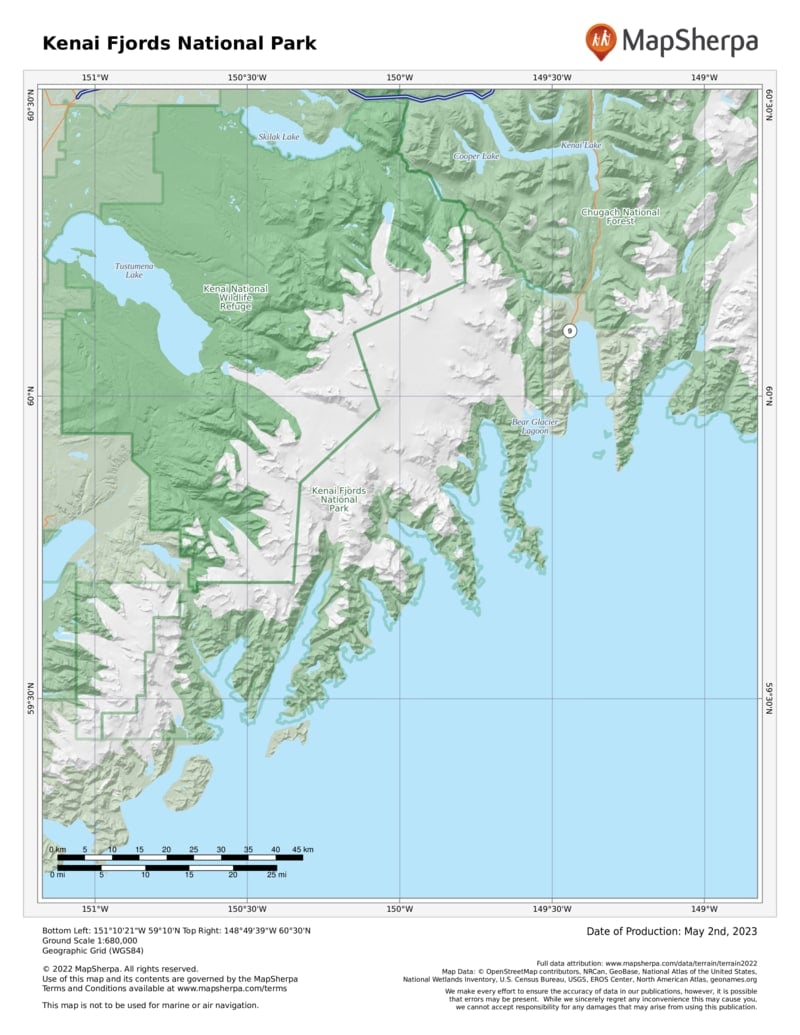The ice is the main draw—but it’s just the start. (Add to the mix bears, birds, and, on the glaciers, ice worms.) The Harding Icefield and the more than 30 glaciers it feeds extend over 700 square miles. A remnant of the Pleistocene era, Harding Icefield was once part of a massive ice sheet that blanketed most of what is now Alaska. A thousand feet thick, ice remains an important part of the landscape, covering some 51 percent of the park. The crown, literally, of Kenai Fjords, Harding Icefield is the largest icefield situated completely within the United States.
As you explore, always check current conditions, and leave no trace.
How to Visit
The best bet for those who want a good overview of the park is to take a day cruise or a flight-seeing trip to see the fjords and the glaciers, and then spend a day hiking to the icefield (or, at least, part of a day to get part of the way—the trail can be quite a challenge). But there also are easy hikes that get you great glacier views. Another way to experience the park is by floatplane or helicopter. The bird’s-eye view underscores the enormity of the park’s icy landscapes. For the unabashedly adventurous? Go deep: Sign up for a multiday paddling trip.
No matter how you decide to enter the park, for safety’s sake keep an eye out for creatures from the start of your adventure.
Kenai is a birder’s delight, with seabirds nesting along the coastline. Watch for puffins speeding by over the water. Up high, train your eye for peregrine falcons or, walking the treeless slopes, mountain goats. And while you are cruising the water, harbor seals could float by on an ice floe, or an orca might, with no warning, leap high into the air, amid shouts of “Did you see that?” coming from your fellow passengers on deck.
Useful Information
How to get there
Take the Seward Highway (Alaska 1, which turns to Alaska 9) south from Anchorage. Leave extra time to make the 126-mile trip on the National Scenic Byway, brimming with photo ops. (Watch for surfers taking on the bore tide.) During summer, RV traffic can slow the drive down. There is daily bus and Alaska Railroad service between Anchorage and Seward during the summer months. Charter flights are also available from Anchorage and Homer.
When to go
Though open year-round, most visitors explore the park during the summer months, when boat trips are offered. Flight-seeing companies run trips yearround out of Seward (subject to cancellation because of harsh weather). The road to Exit Glacier usually opens in late spring; it closes to car traffic with the first snowfall. Once there’s enough snow coverage, the 7-mile road opens to those who want to trek, dog-sled, or cross-country ski. Hikers and bicyclists are allowed on the road year-round.
Visitor Centers
The Kenai Fjords National Park Visitor Center at Seward’s small harbor is open mid-May to mid-Sept. The Exit Glacier Nature Center is at the Exit Glacier trailhead.
Headquarters
411 Washington Street Seward, AK 99664 nps.gov/kefj 907-422-0500
Camping
The park’s established campground (12 sites) is first come, first served. The park also offers two summer-use cabins (see p. 494). There’s also a winter-only cabin: Willow Cabin at Exit Glacier. For cabin reservations, 907-644-3661.
Lodging
In the park there’s concessioneroperated Kenai Fjords Glacier Lodge (kenaifjordsglacierlodge.com). Seward (seward.com; 907-224-8051) offers lodging options.
US National Parks Map
About the Guide



